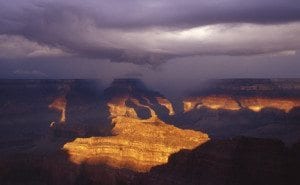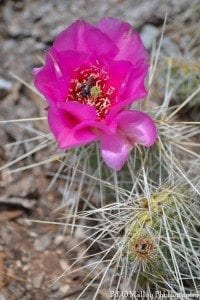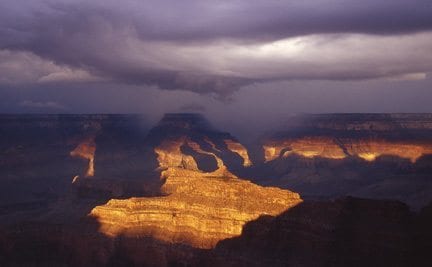Grand Canyon Experts | A conversation with Rose Houk
Q Tell us about your experience in this region of the Southwest and in particular with Grand Canyon?

Photo by Gary Ladd
A I worked a newspaper job in college and saved enough for a trip out West in a VW square back. We came to Grand Canyon and of course we hiked down. We hiked down the Kaibab Trail and stayed at Bright Angel campground. This was in the early ‘70s and the gear was pretty heavy then – I think we had a heavy canvas tent. After the trip I thought to myself: ‘I won’t ever have to do this again.’ It was really tough. But I did come back – this time to Grand Canyon and through the region in a 1959 Ford panel van. This time I came out West to stay and live. I asked one of the Grand Canyon National Park Rangers: ‘How do you get to be a park ranger?’ The answer was you volunteer. So that’s what I did: I signed up to be a VIP, a Volunteer in Parks and did that for about six weeks. I was working at Shrine of the Ages helping organize the Park’s photographic slide files.
Q. When was that?
A. That was in April of 1976, and that is when I also first started getting interested in and learning about plants and flowers of Grand Canyon. I was fortunate to get opportunities to do hikes with people who knew the plants, and so I started learning about Grand Canyon natural history. As a volunteer I got in on a good bit of that kind of insider info particularly about the plants and plant communities.
So after that time, all I wanted to do was be a Park Ranger, so I kept applying and applying for those seasonal jobs. Finally, I got a call and was asked – on very short notice – when I could start. Dad said, ‘pack your jeans in your backpack and go.’ So I worked for the National Park Service on the South Rim giving talks and doing evening programs as an interpretive naturalist – that first summer was in 1979. I also got seasonal jobs for the Grand Canyon Natural History Association and as a result I spent two years working for the Association in the winters and for the National Park Service doing natural history interpretation in the summers. Those were two of the best years in my life.
Q Generally speaking what was the living situation like at Grand Canyon?
A Well you had to have a job with the Park or related things to live at Grand Canyon. But in some ways living there is like living in a bubble – your life is the Park Service, your friends are all in the Park Service. Anyway, as a result of my experiences there I wrote my first book: Guide to South Kaibab Trail, published by the Grand Canyon Natural History Association – it first came out in 1980 or 1981.
Q Was that research on the South Kaibab trail one of the things that really got you started in focusing on plants, the flora, of Grand Canyon?
A Yes. For me the plants there are really an attraction. I’m an amateur botanist. What’s

Photo by P.J. O'Malley
great about the plants is that they are unique to a place. If you start to learn the plants I think you gain a deeper appreciation of a place. That’s true certainly of Grand Canyon. In the spring there’s nothing more beautiful that to hike down and see the wildflowers blooming. You encounter the penstemons on the Kaibab Limestone, and pink phlox. As you get down deeper in the Canyon you see the brittlebrush and the agaves – century plants – and, they are amazing. They send up an enormous stalk and if you come back in even the short span of a week or two it’s astonishing to see how much those stalks have grown. I would say the plants of the Canyon give the Canyon character. There is so much variety, diversity when you hike down through those different life zones.
Q What else can you tell us about this remarkable, but sometimes under appreciated flora of Grand Canyon?
A The Grand Canyon is way up there in the sheer amount of species diversity, the number of different kinds of plants. To me it’s about stopping and looking around – I’m always stopping and looking at something growing, so I tend to be a pretty slow hiker sometimes. Say on the Kaibab trail, everyone wants to zip down and get to the River. But in the spring – particularly in a wet year – there has been so much water that everything is blooming. I’ve also done river trips and encountered shrubs in a place that are at least a century old! On one project I was part of we did repeat photography and took photos from locations that were exact matches in location from historical photos taken 100 years earlier. It’s for a book by Bob Webb called A Century of Change.
Q What are some of the plants that come to mind when you think of plants of the Grand Canyon?
A There is the sentry milkvetch (Astragalus cremnophylax) at Hopi Point. It is endemic to there; that means it’s restricted in its range of where it occurs to that locality or region. Because it is a federally listed endangered species, they are trying to protect that particular plant at Hopi Point. Also down at Colorado River level there is prince’s plume (Stanleya pinnata) – sometimes, if you look very closely, there is a little yellow crab spider on it and it’s the same color as the flower.
On the South Rim you’ll also find the sego lily (Calochortus nuttalii) – sometimes I’ve even seen fields of these delicate, magnificent flowers. Another plant that comes to mind is the western redbud (Cercis occidentalis) I like to hike a short way down the Hermit Trail – it’s only about a 1 and ½ to 2 miles down – where there is a red rock alcove and where this plant can be found.
Q So you are suggesting a visitor doesn’t have to go far or try to take in everything during a visit to really begin to appreciate the Canyon?
A Actually, there are two things. Go and sit on a rock away from people – there are lots of places even in the 1½ miles between Yavapai Museum and Grand Canyon Village. You can begin to grasp the Canyon even if you only go for a short distance – you’ve got to see the details – to begin to grasp it. That’s when you really appreciate what the place is all about. The other thing I recommend is to go down a trail like say the Kaibab Trail or the Hermit Trail, a short distance, down to Hermit Basin and sit on a rock – one of the best ways to take it in is to just sit there and let the silence sink in. Go and watch the condors, watch ravens fly by, watch the clouds. The key to the Canyon is just the silence, that’s something that people may not think about. I have to go and sit there and not talk. The Grand Canyon, you can’t grasp it, it’s so hard to grasp it anyway. But one of the best ways is to sit there and let the silence sink in.
Rose Houk is a Flagstaff-based freelance writer and editor specializing in natural history, history, and archaeology. She first came to Arizona to work as a ranger-naturalist at Grand Canyon National Park. As publications assistant for Grand Canyon Association, she wrote her first book – A Guide to the South Kaibab Trail – followed by An Introduction to Grand Canyon Ecology. She went on to work as natural sciences editor at University of Arizona Press. Rose is author of many publications about national parks and monuments, including The Guide to National Parks of the Southwest. Other recent publications include books on butterflies and hummingbirds, and several works about people and places of the Great Smoky Mountains. She is also the author of The Mountains Know Arizona, with photographer Michael Collier, winner of the National Outdoor Book Award; Wild Cactus, with photographer George H. H. Huey; and editor of the anthology, Mesa Verde National Park: The First 100 Years. She is a frequent contributor to KNAU (Arizona) Public Radio and writes for Smokies Life and Sojourns magazines.
Resources and for further reading:
South Kaibab (Grand Canyon Trail Guide), Rose Houk, Grand Canyon Association, 1996.
The Guide to National Parks of the Southwest, Rose Houk, Western National Parks Association, 2005.
Grand Canyon, A Century of Change, Rephotography of the 1889-1890 Stanton Expedition, Robert H. Webb, University of Arizona Press, 1996.
NAU Elderhostel/Road Scholar – Adventures in Lifelong Learning
Plant Guide to Bright Angel Trail, Grand Canyon National Park [online] © 2007-2009 by Tom Chester, Anne Kelly and Brendan Crill




